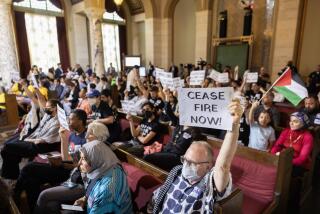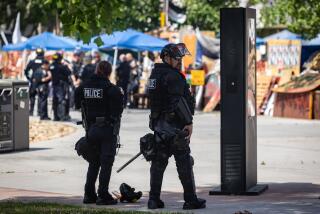Occupy L.A.: Ending the occupation
- Share via
Right about now, we suspect City Council President Eric Garcetti is regretting telling protesters with the Occupy Los Angeles movement camping outside City Hall that they were welcome to “stay as long as you need to.” And Mayor Antonio Villaraigosa might be rethinking his decision to hand out ponchos when the weather turned wet. It’s even possible (though unlikely) that Councilman Richard Alarcon is thinking twice about pandering to the movement by using it as an excuse to resurrect his misguided proposal to shift L.A. funds to community-oriented financial institutions, a move that could cost the city at least $58 million.
Four weeks after protesters converged on the Civic Center, they are wearing out their welcome. Even some of the city’s most liberal politicians, who initially embraced them, are trying to figure out a graceful way of getting them to go home.
That may not be possible. Occupy Los Angeles, an offshoot of the national Occupy Wall Street movement, is a viral demonstration that prides itself on a lack of leadership or central organization. In the past, police and public officials have often been able to negotiate a peaceful end to major demonstrations by engaging in a kind of theatrical performance in which the leaders agree on who will be arrested to make a political statement, and police agree not to use their batons. But it’s hard to negotiate with a headless group united only by its resentment toward bankers, corporations, Congress, the media and others in positions of power — including the police.
In fact, for the Occupy protesters, being rousted by police may pose strategic advantages. Videos of alleged police brutality shot by demonstrators in New York and Oakland have quickly become Internet sensations, bringing publicity to the movement and increasing public participation. In Oakland, where police used tear gas to evict demonstrators from their encampment near City Hall on Tuesday night and an Iraq war vet was hospitalized after being struck in the head by a tear gas canister, the incident has strengthened the protesters, who are now calling for a general strike to shut down city operations.
The last thing Los Angeles needs is a repeat of what happened in Oakland. The demonstrators haven’t made themselves a public nuisance to the extent they did in the East Bay, and there is no reason to rush a confrontation. At the same time, though, it’s becoming increasingly clear that they can’t be allowed to camp out at City Hall forever. They’re killing the lawn in one of downtown’s rare green spaces, which will have to be replaced at taxpayer expense, and they may be damaging City Hall’s majestic fig trees. Merchants who normally set up a weekly farmers market on the lawn have been forced to set up in a plaza across the street, and there are obvious sanitation, vermin and public-health problems that come with an impromptu encampment in an urban zone that wasn’t intended to accommodate it. Besides, it’s against the law to camp in city parks after 10:30 p.m.
So what are city officials to do? Complicating the answer is that some of the same politicians now urging the protesters to leave were only too eager to roll out the welcome mat a few weeks ago. Villaraigosa on Wednesday said the demonstrators must obey local rules and regulations and that the encampment “cannot continue indefinitely.” Downtown business groups are said to be pressuring City Council members to close down what’s looking more like a Hooverville than a protest, and City Atty. Carmen Trutanich has urged police to enforce the law on nighttime camping. Yet on Oct. 12, the council unanimously approved a resolution expressing support for “the continuation of the peaceful and vibrant exercise in 1st Amendment rights carried out by ‘Occupy Los Angeles.’”
The protesters, meanwhile, have made it clear that they don’t intend to leave. “As a time stamp for our departure, there is none,” they wrote in a joint statement Wednesday night.
It would be best for everybody, including the demonstrators, if the impasse could be resolved without resorting to police in riot gear. Another location for the protest should be found, and if the participants are organized enough to put out a joint statement, they’re organized enough to negotiate a peaceful departure.
More to Read
A cure for the common opinion
Get thought-provoking perspectives with our weekly newsletter.
You may occasionally receive promotional content from the Los Angeles Times.









